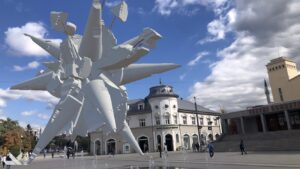

In the heart of Skanderbeg Square in Prishtina, a unique art project has blossomed that looks like a huge flower, bringing together creativity, technology, and a powerful message of hope - weaving together real art with the digital world.
In the midst of Prishtina, a parallel reality unfolded, accessible with a simple click on a smartphone—a hybrid artwork experienced. Near a large flower, existential questions arise. Whose fragments are these, brought together to form a blossom? Pieces of a once-lived yet shattered world have gathered to illuminate a beacon of hope.
The Dutch artist and policy advisor for Art and Culture Eijsden-Margraten in Netherlands, Maureen Bachaus, in collaboration with a team, has crafted an unique Augmented Reality, AR, sculpture that stands as a symbol of resilience and positivity.

“This way, these fragments become a symbol of hope and positive thinking. This project is therefore not only a unique experience, but also allows people to see how art can contribute to a societal goal,” said Bachaus in an interview for Prishtina Insight.
Maureen Bachaus is well-known as an artist who delves into societal themes through a unique personal lens. Her creations are grounded in the examination of the individual perspectives of people across diverse cultures and backgrounds.
AR sculpture, a part of a series installed across various countries, takes the form of a white flower. What makes it truly exceptional is its composition—built from fragments of society, remnants of once-destroyed buildings.
The concept of this nomadic artwork lies in the idea that individuals can navigate through periods of unprecedented change. Within this uncertainty, there exists the potent ability to shape the future, viewing the fragments as shattered pieces of existence—a paradoxical yet symbolic representation of hope.
Through phones, Augmented Reality transports people into a frameless world that encompasses conceptual text, photographs, and an added reality artwork.
Telephones unfortunately or fortunately have become an integral part of human existence, akin to an extension of our hands. Through this unprecedented artwork in Prishtina, Bachaus aimed to showcase the power of art in transforming people’s lives and conveying a meaningful message.
When you approach the location of the artwork, at a distance of approximately 200 meters, in the Kyck application, a button with the words ‘Experience Now’ will appear. There you experience another level of parallel reality through virtuality.
The team prioritized accessibility, ensuring that anyone with an up-to-date mobile phone can experience the artwork. An online manual provides easy-to-follow steps for users eager to explore this unique AR experience. The collaboration brought to life an immersive AR experience, seamlessly integrated with Google Maps for accessibility.
Skanderbeg Square, chosen not just for its central location but for its ability to connect the past and present, served as the canvas for this remarkable artwork. The integration of the AR sculpture adds a layer of connection with the future, emphasizing the resilience of people and their thoughts.
“And by realizing this artwork, it also establishes a strong connection with the future, with people and their thoughts and their personal strength as a foundation,” said Bachaus.
The creation of this digital piece spanned over six months. Starting with a 2D design, the team progressed to a scaled 3D model, ultimately translating it into a digital 3D model. The transformation into an AR experience required meticulous planning and technical expertise, involving the team at STRUQT BV, a trans-disciplinary media and interaction company from the Netherlands and Albanian curator, Jeton Muja.
Bachaus and Muja’s art collective is called BAUM.
The impact of the project extends beyond the digital realm. The team regularly receives enthusiastic feedback and selfies from individuals captivated by the AR artwork. The joyous response reflects the success of the project in merging art with a societal goal.
Thrilled by the positive reception, the team is working with the Dutch Embassy in Prishtina to explore the possibilities of a permanent QR panel in Skanderbeg Square. This initiative ensures that the artwork’s beauty and message endure for generations.
The project was a response to an invitation from the NoMade Bienal and the Faculty of Arts of the University of Prishtina, with crucial support from the Dutch Embassy in Kosovo.
The Prishtina curator of the University is Ismet Jonuzi, and the South-American curator of the Bienal is Fernando Hierro.
Bachaus has presented her works in numerous solo and group exhibitions in museums and galleries in the Netherlands and abroad, and featured her projects in biennials and festivals such as BIO 50, 24th Biennial of Design, MAO – Museum of Architecture and Design, Ljubljana, in 2014, and at the DokuFest International Documentary Film Festival, Prizren, Kosovo, in 2015. Her work has been recently featured at art fairs, such as SCOPE Basel, Switzerland, in 2017 and 2018, and Rotterdam Contemporary Art Fair, The Netherlands, in 2017.
20 October 2023 - 17:32